Analysis of Exchange Rate Determination Theories and Systems
VerifiedAdded on 2023/06/04
|14
|4114
|187
Report
AI Summary
This report, prepared by a student, provides a comprehensive overview of exchange rate determination, focusing on the evolution of exchange rate systems and the prominent theories that explain their behavior. It begins by tracing the historical development of exchange rates, from the gold standard to the floating exchange rate system adopted after the Bretton Woods agreement. The report then delves into various exchange rate systems, including floating, pegged, and hybrid systems, discussing their mechanisms and implications. A significant portion of the report is dedicated to the theory of Purchasing Power Parity (PPP), explaining both its absolute and relative versions, and illustrating its application with real-life examples. The report also touches upon other theories like Mint Parity, Balance of Payments, Portfolio Balance, and Monetary approaches. It also provides a critical analysis of the PPP theory, including its limitations and empirical tests. Finally, it provides conclusion on the topic.
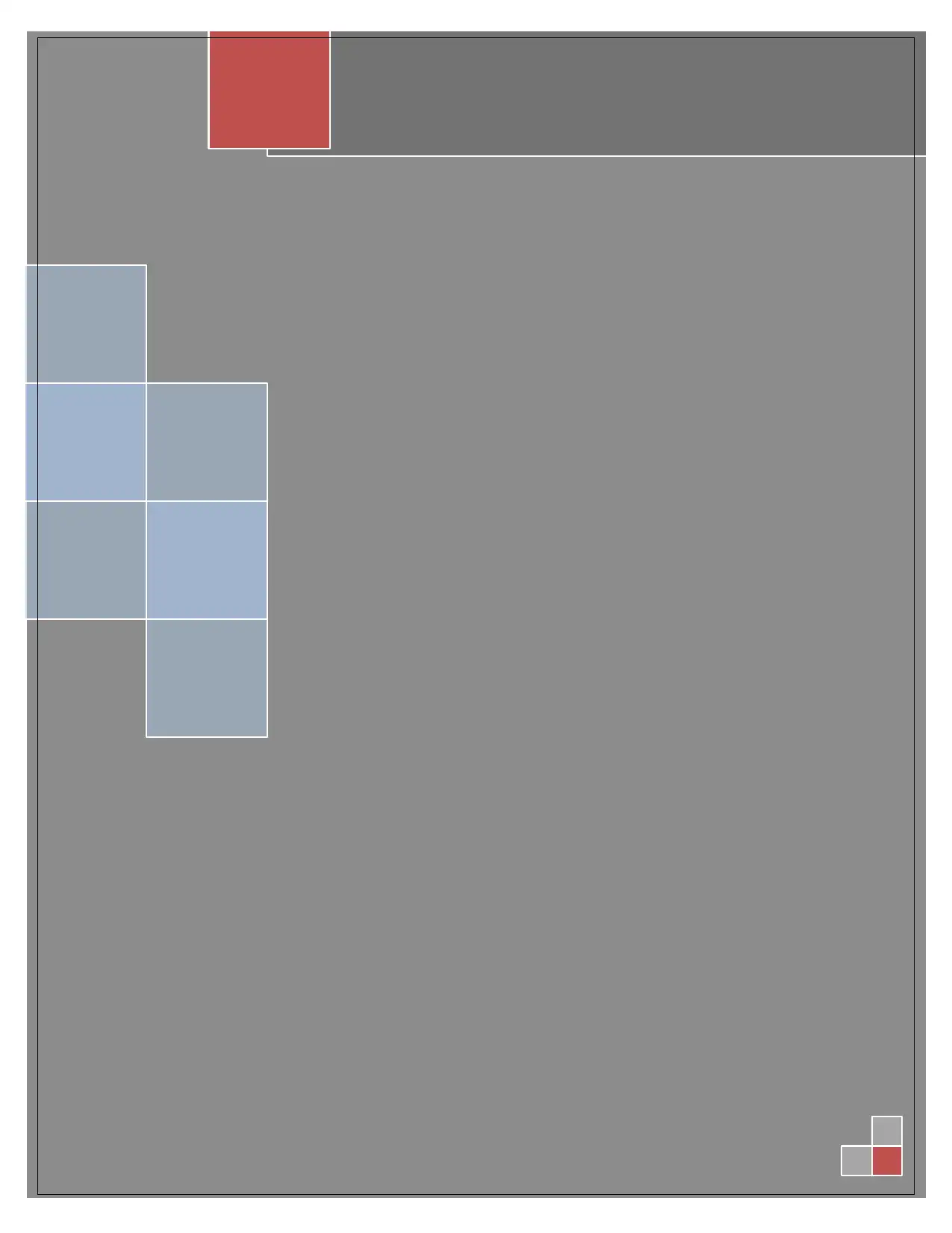
Paraphrase This Document
Need a fresh take? Get an instant paraphrase of this document with our AI Paraphraser
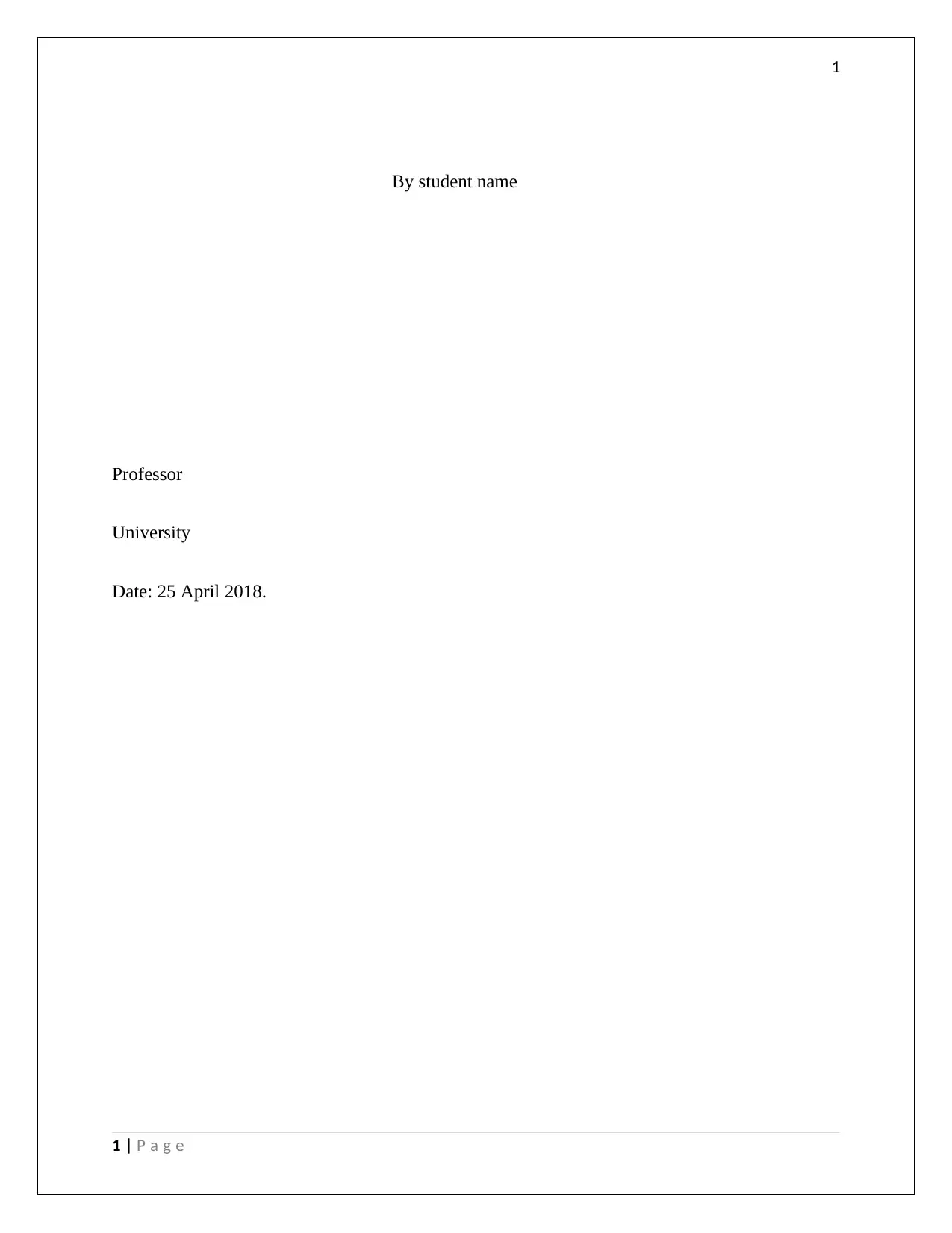
1
By student name
Professor
University
Date: 25 April 2018.
1 | P a g e
By student name
Professor
University
Date: 25 April 2018.
1 | P a g e
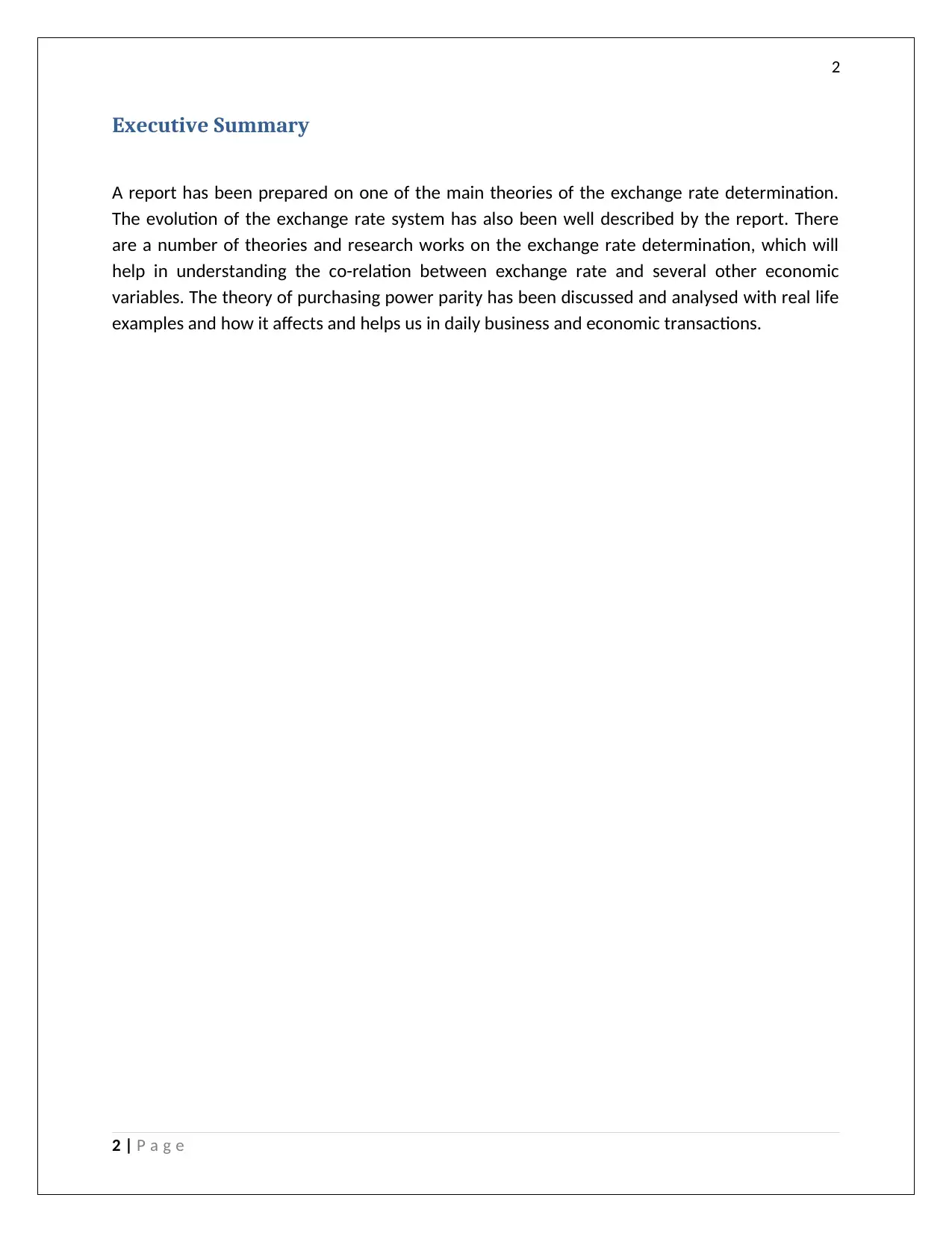
2
Executive Summary
A report has been prepared on one of the main theories of the exchange rate determination.
The evolution of the exchange rate system has also been well described by the report. There
are a number of theories and research works on the exchange rate determination, which will
help in understanding the co-relation between exchange rate and several other economic
variables. The theory of purchasing power parity has been discussed and analysed with real life
examples and how it affects and helps us in daily business and economic transactions.
2 | P a g e
Executive Summary
A report has been prepared on one of the main theories of the exchange rate determination.
The evolution of the exchange rate system has also been well described by the report. There
are a number of theories and research works on the exchange rate determination, which will
help in understanding the co-relation between exchange rate and several other economic
variables. The theory of purchasing power parity has been discussed and analysed with real life
examples and how it affects and helps us in daily business and economic transactions.
2 | P a g e
⊘ This is a preview!⊘
Do you want full access?
Subscribe today to unlock all pages.

Trusted by 1+ million students worldwide
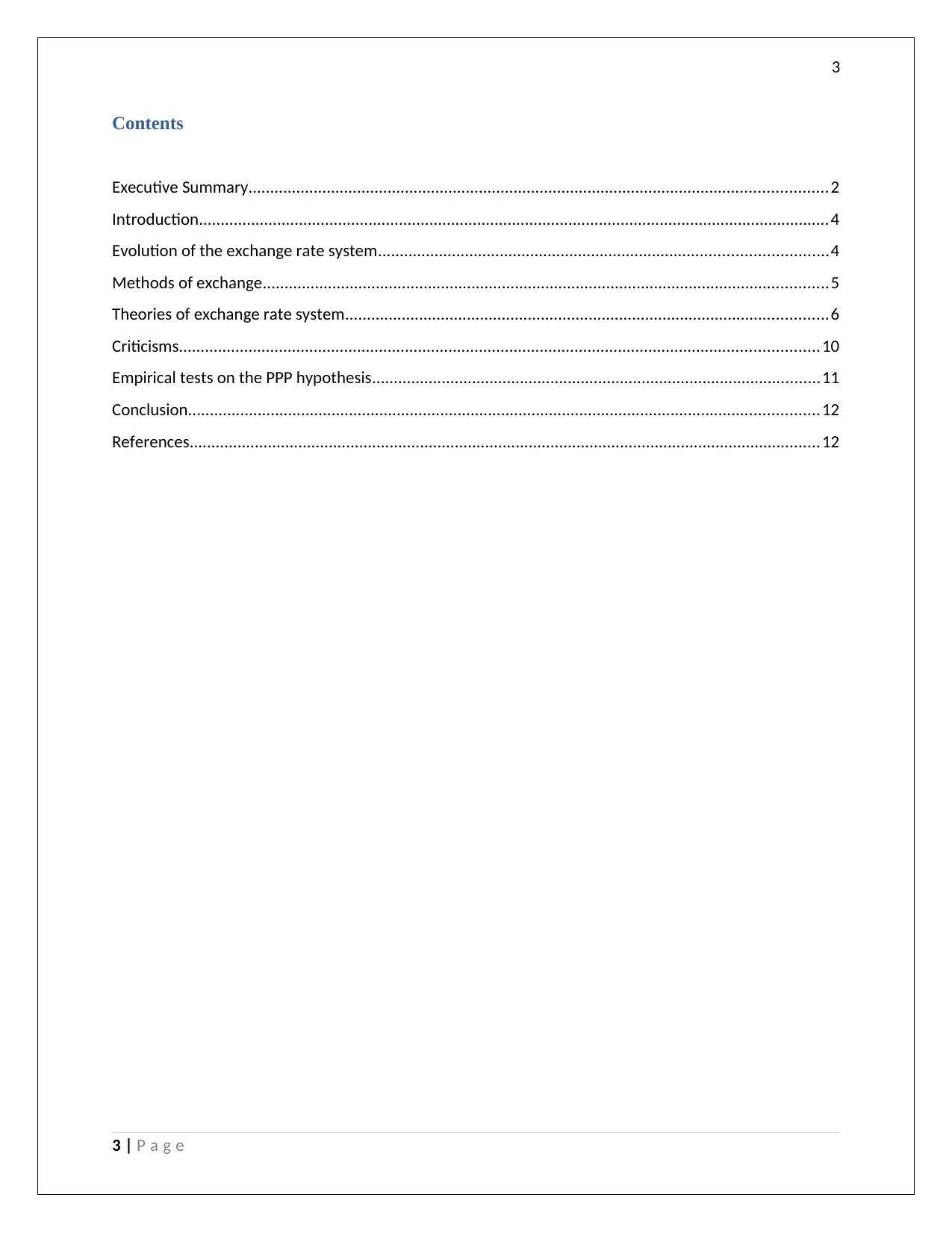
3
Contents
Executive Summary.....................................................................................................................................2
Introduction.................................................................................................................................................4
Evolution of the exchange rate system.......................................................................................................4
Methods of exchange..................................................................................................................................5
Theories of exchange rate system...............................................................................................................6
Criticisms...................................................................................................................................................10
Empirical tests on the PPP hypothesis.......................................................................................................11
Conclusion.................................................................................................................................................12
References.................................................................................................................................................12
3 | P a g e
Contents
Executive Summary.....................................................................................................................................2
Introduction.................................................................................................................................................4
Evolution of the exchange rate system.......................................................................................................4
Methods of exchange..................................................................................................................................5
Theories of exchange rate system...............................................................................................................6
Criticisms...................................................................................................................................................10
Empirical tests on the PPP hypothesis.......................................................................................................11
Conclusion.................................................................................................................................................12
References.................................................................................................................................................12
3 | P a g e
Paraphrase This Document
Need a fresh take? Get an instant paraphrase of this document with our AI Paraphraser
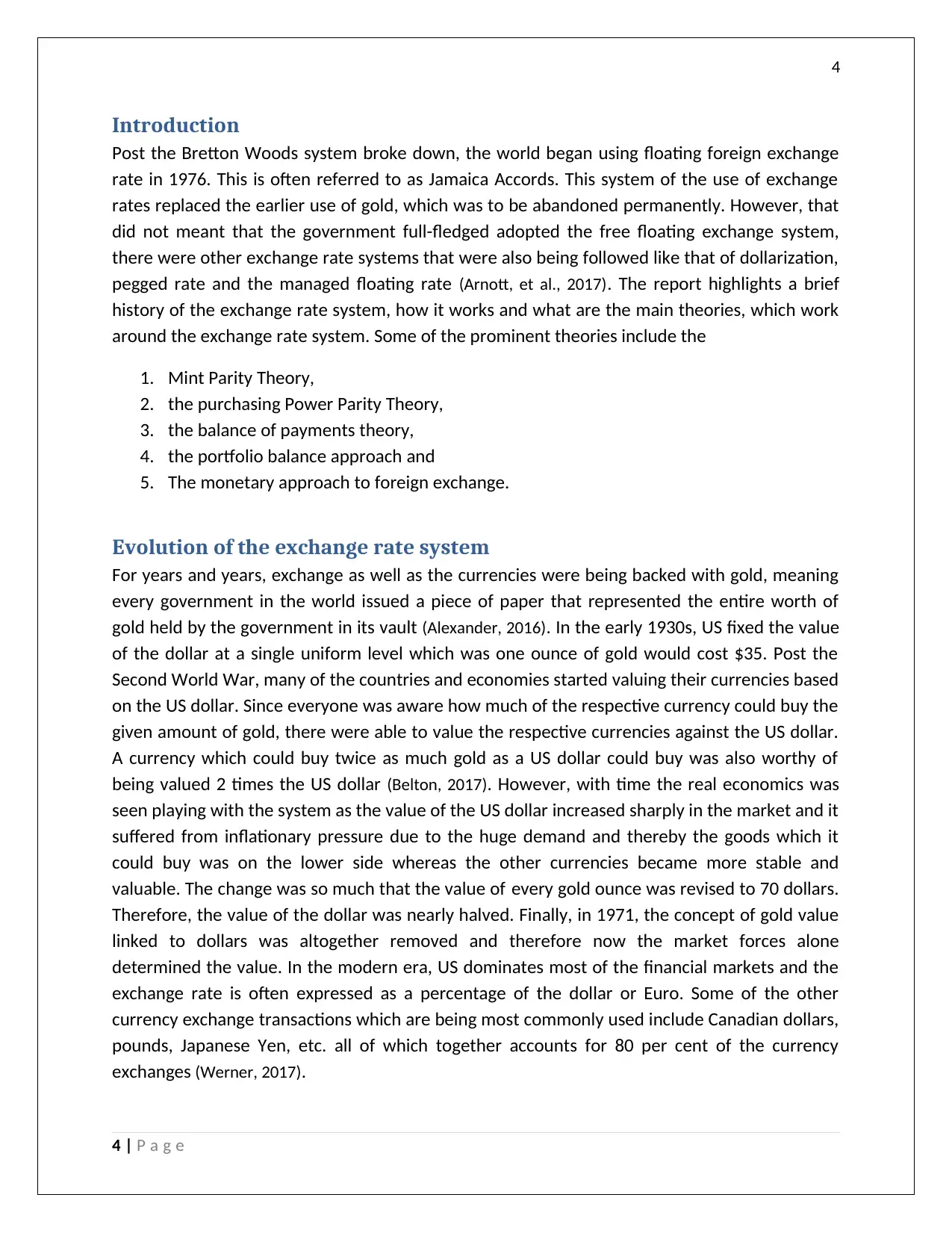
4
Introduction
Post the Bretton Woods system broke down, the world began using floating foreign exchange
rate in 1976. This is often referred to as Jamaica Accords. This system of the use of exchange
rates replaced the earlier use of gold, which was to be abandoned permanently. However, that
did not meant that the government full-fledged adopted the free floating exchange system,
there were other exchange rate systems that were also being followed like that of dollarization,
pegged rate and the managed floating rate (Arnott, et al., 2017). The report highlights a brief
history of the exchange rate system, how it works and what are the main theories, which work
around the exchange rate system. Some of the prominent theories include the
1. Mint Parity Theory,
2. the purchasing Power Parity Theory,
3. the balance of payments theory,
4. the portfolio balance approach and
5. The monetary approach to foreign exchange.
Evolution of the exchange rate system
For years and years, exchange as well as the currencies were being backed with gold, meaning
every government in the world issued a piece of paper that represented the entire worth of
gold held by the government in its vault (Alexander, 2016). In the early 1930s, US fixed the value
of the dollar at a single uniform level which was one ounce of gold would cost $35. Post the
Second World War, many of the countries and economies started valuing their currencies based
on the US dollar. Since everyone was aware how much of the respective currency could buy the
given amount of gold, there were able to value the respective currencies against the US dollar.
A currency which could buy twice as much gold as a US dollar could buy was also worthy of
being valued 2 times the US dollar (Belton, 2017). However, with time the real economics was
seen playing with the system as the value of the US dollar increased sharply in the market and it
suffered from inflationary pressure due to the huge demand and thereby the goods which it
could buy was on the lower side whereas the other currencies became more stable and
valuable. The change was so much that the value of every gold ounce was revised to 70 dollars.
Therefore, the value of the dollar was nearly halved. Finally, in 1971, the concept of gold value
linked to dollars was altogether removed and therefore now the market forces alone
determined the value. In the modern era, US dominates most of the financial markets and the
exchange rate is often expressed as a percentage of the dollar or Euro. Some of the other
currency exchange transactions which are being most commonly used include Canadian dollars,
pounds, Japanese Yen, etc. all of which together accounts for 80 per cent of the currency
exchanges (Werner, 2017).
4 | P a g e
Introduction
Post the Bretton Woods system broke down, the world began using floating foreign exchange
rate in 1976. This is often referred to as Jamaica Accords. This system of the use of exchange
rates replaced the earlier use of gold, which was to be abandoned permanently. However, that
did not meant that the government full-fledged adopted the free floating exchange system,
there were other exchange rate systems that were also being followed like that of dollarization,
pegged rate and the managed floating rate (Arnott, et al., 2017). The report highlights a brief
history of the exchange rate system, how it works and what are the main theories, which work
around the exchange rate system. Some of the prominent theories include the
1. Mint Parity Theory,
2. the purchasing Power Parity Theory,
3. the balance of payments theory,
4. the portfolio balance approach and
5. The monetary approach to foreign exchange.
Evolution of the exchange rate system
For years and years, exchange as well as the currencies were being backed with gold, meaning
every government in the world issued a piece of paper that represented the entire worth of
gold held by the government in its vault (Alexander, 2016). In the early 1930s, US fixed the value
of the dollar at a single uniform level which was one ounce of gold would cost $35. Post the
Second World War, many of the countries and economies started valuing their currencies based
on the US dollar. Since everyone was aware how much of the respective currency could buy the
given amount of gold, there were able to value the respective currencies against the US dollar.
A currency which could buy twice as much gold as a US dollar could buy was also worthy of
being valued 2 times the US dollar (Belton, 2017). However, with time the real economics was
seen playing with the system as the value of the US dollar increased sharply in the market and it
suffered from inflationary pressure due to the huge demand and thereby the goods which it
could buy was on the lower side whereas the other currencies became more stable and
valuable. The change was so much that the value of every gold ounce was revised to 70 dollars.
Therefore, the value of the dollar was nearly halved. Finally, in 1971, the concept of gold value
linked to dollars was altogether removed and therefore now the market forces alone
determined the value. In the modern era, US dominates most of the financial markets and the
exchange rate is often expressed as a percentage of the dollar or Euro. Some of the other
currency exchange transactions which are being most commonly used include Canadian dollars,
pounds, Japanese Yen, etc. all of which together accounts for 80 per cent of the currency
exchanges (Werner, 2017).
4 | P a g e
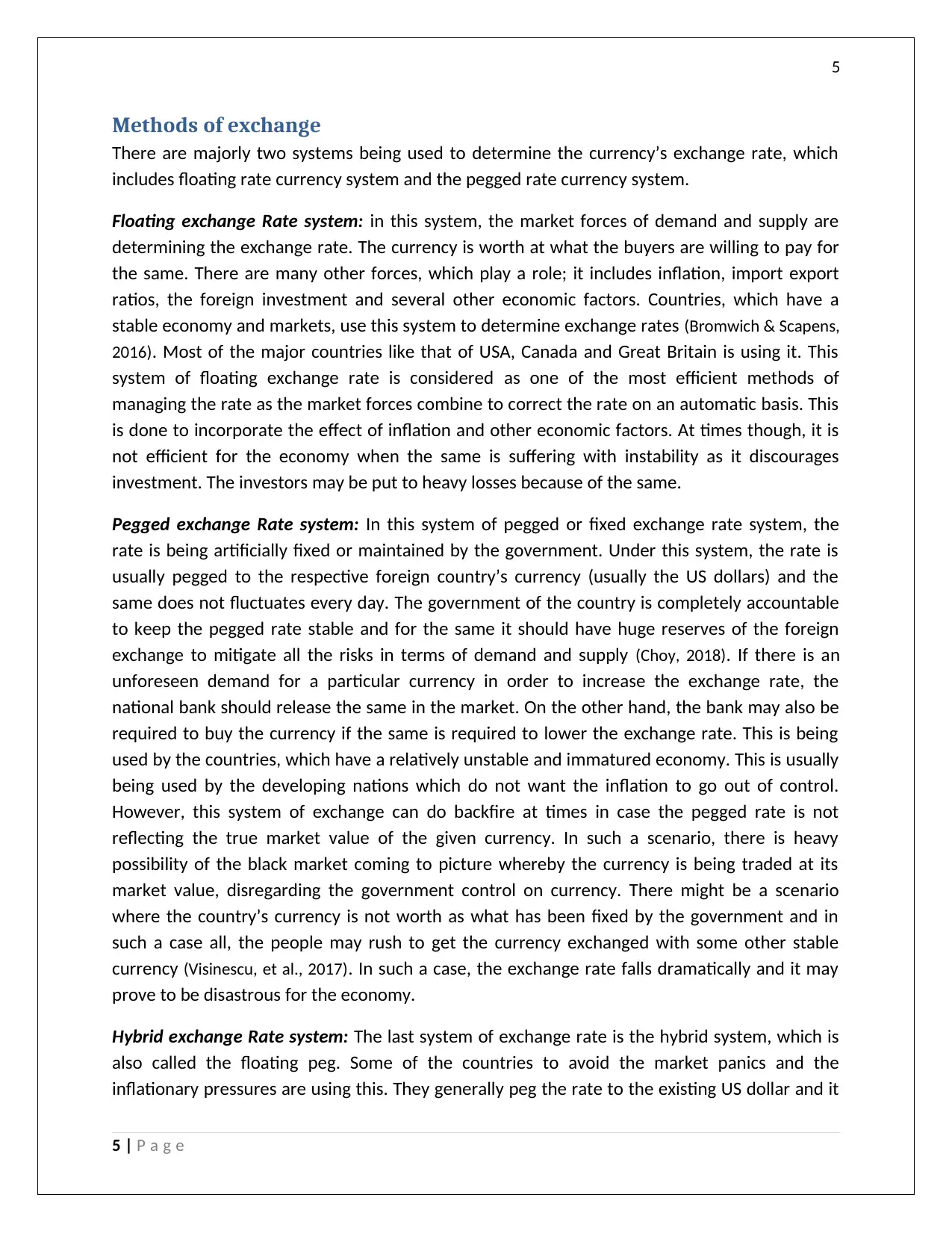
5
Methods of exchange
There are majorly two systems being used to determine the currency’s exchange rate, which
includes floating rate currency system and the pegged rate currency system.
Floating exchange Rate system: in this system, the market forces of demand and supply are
determining the exchange rate. The currency is worth at what the buyers are willing to pay for
the same. There are many other forces, which play a role; it includes inflation, import export
ratios, the foreign investment and several other economic factors. Countries, which have a
stable economy and markets, use this system to determine exchange rates (Bromwich & Scapens,
2016). Most of the major countries like that of USA, Canada and Great Britain is using it. This
system of floating exchange rate is considered as one of the most efficient methods of
managing the rate as the market forces combine to correct the rate on an automatic basis. This
is done to incorporate the effect of inflation and other economic factors. At times though, it is
not efficient for the economy when the same is suffering with instability as it discourages
investment. The investors may be put to heavy losses because of the same.
Pegged exchange Rate system: In this system of pegged or fixed exchange rate system, the
rate is being artificially fixed or maintained by the government. Under this system, the rate is
usually pegged to the respective foreign country’s currency (usually the US dollars) and the
same does not fluctuates every day. The government of the country is completely accountable
to keep the pegged rate stable and for the same it should have huge reserves of the foreign
exchange to mitigate all the risks in terms of demand and supply (Choy, 2018). If there is an
unforeseen demand for a particular currency in order to increase the exchange rate, the
national bank should release the same in the market. On the other hand, the bank may also be
required to buy the currency if the same is required to lower the exchange rate. This is being
used by the countries, which have a relatively unstable and immatured economy. This is usually
being used by the developing nations which do not want the inflation to go out of control.
However, this system of exchange can do backfire at times in case the pegged rate is not
reflecting the true market value of the given currency. In such a scenario, there is heavy
possibility of the black market coming to picture whereby the currency is being traded at its
market value, disregarding the government control on currency. There might be a scenario
where the country’s currency is not worth as what has been fixed by the government and in
such a case all, the people may rush to get the currency exchanged with some other stable
currency (Visinescu, et al., 2017). In such a case, the exchange rate falls dramatically and it may
prove to be disastrous for the economy.
Hybrid exchange Rate system: The last system of exchange rate is the hybrid system, which is
also called the floating peg. Some of the countries to avoid the market panics and the
inflationary pressures are using this. They generally peg the rate to the existing US dollar and it
5 | P a g e
Methods of exchange
There are majorly two systems being used to determine the currency’s exchange rate, which
includes floating rate currency system and the pegged rate currency system.
Floating exchange Rate system: in this system, the market forces of demand and supply are
determining the exchange rate. The currency is worth at what the buyers are willing to pay for
the same. There are many other forces, which play a role; it includes inflation, import export
ratios, the foreign investment and several other economic factors. Countries, which have a
stable economy and markets, use this system to determine exchange rates (Bromwich & Scapens,
2016). Most of the major countries like that of USA, Canada and Great Britain is using it. This
system of floating exchange rate is considered as one of the most efficient methods of
managing the rate as the market forces combine to correct the rate on an automatic basis. This
is done to incorporate the effect of inflation and other economic factors. At times though, it is
not efficient for the economy when the same is suffering with instability as it discourages
investment. The investors may be put to heavy losses because of the same.
Pegged exchange Rate system: In this system of pegged or fixed exchange rate system, the
rate is being artificially fixed or maintained by the government. Under this system, the rate is
usually pegged to the respective foreign country’s currency (usually the US dollars) and the
same does not fluctuates every day. The government of the country is completely accountable
to keep the pegged rate stable and for the same it should have huge reserves of the foreign
exchange to mitigate all the risks in terms of demand and supply (Choy, 2018). If there is an
unforeseen demand for a particular currency in order to increase the exchange rate, the
national bank should release the same in the market. On the other hand, the bank may also be
required to buy the currency if the same is required to lower the exchange rate. This is being
used by the countries, which have a relatively unstable and immatured economy. This is usually
being used by the developing nations which do not want the inflation to go out of control.
However, this system of exchange can do backfire at times in case the pegged rate is not
reflecting the true market value of the given currency. In such a scenario, there is heavy
possibility of the black market coming to picture whereby the currency is being traded at its
market value, disregarding the government control on currency. There might be a scenario
where the country’s currency is not worth as what has been fixed by the government and in
such a case all, the people may rush to get the currency exchanged with some other stable
currency (Visinescu, et al., 2017). In such a case, the exchange rate falls dramatically and it may
prove to be disastrous for the economy.
Hybrid exchange Rate system: The last system of exchange rate is the hybrid system, which is
also called the floating peg. Some of the countries to avoid the market panics and the
inflationary pressures are using this. They generally peg the rate to the existing US dollar and it
5 | P a g e
⊘ This is a preview!⊘
Do you want full access?
Subscribe today to unlock all pages.

Trusted by 1+ million students worldwide
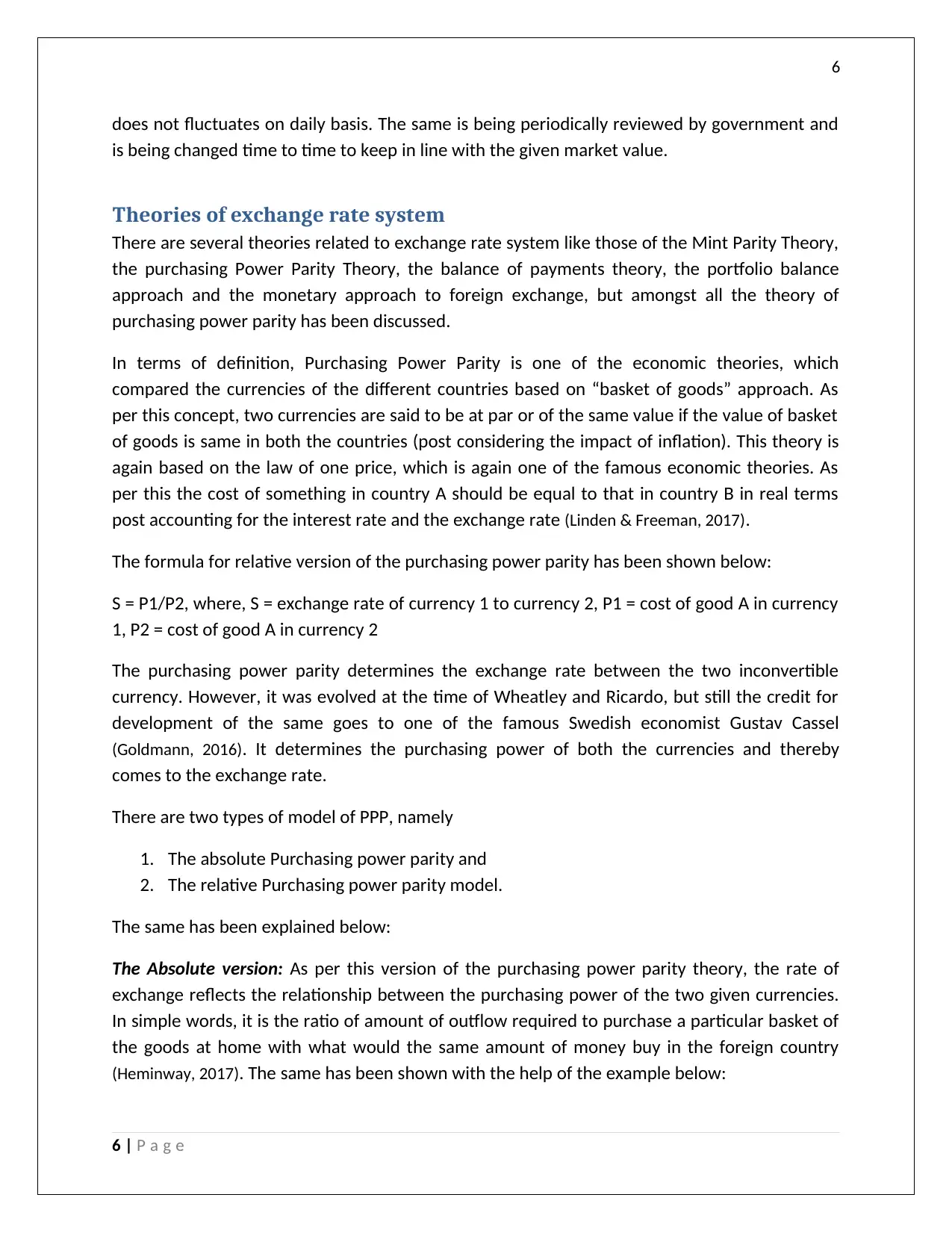
6
does not fluctuates on daily basis. The same is being periodically reviewed by government and
is being changed time to time to keep in line with the given market value.
Theories of exchange rate system
There are several theories related to exchange rate system like those of the Mint Parity Theory,
the purchasing Power Parity Theory, the balance of payments theory, the portfolio balance
approach and the monetary approach to foreign exchange, but amongst all the theory of
purchasing power parity has been discussed.
In terms of definition, Purchasing Power Parity is one of the economic theories, which
compared the currencies of the different countries based on “basket of goods” approach. As
per this concept, two currencies are said to be at par or of the same value if the value of basket
of goods is same in both the countries (post considering the impact of inflation). This theory is
again based on the law of one price, which is again one of the famous economic theories. As
per this the cost of something in country A should be equal to that in country B in real terms
post accounting for the interest rate and the exchange rate (Linden & Freeman, 2017).
The formula for relative version of the purchasing power parity has been shown below:
S = P1/P2, where, S = exchange rate of currency 1 to currency 2, P1 = cost of good A in currency
1, P2 = cost of good A in currency 2
The purchasing power parity determines the exchange rate between the two inconvertible
currency. However, it was evolved at the time of Wheatley and Ricardo, but still the credit for
development of the same goes to one of the famous Swedish economist Gustav Cassel
(Goldmann, 2016). It determines the purchasing power of both the currencies and thereby
comes to the exchange rate.
There are two types of model of PPP, namely
1. The absolute Purchasing power parity and
2. The relative Purchasing power parity model.
The same has been explained below:
The Absolute version: As per this version of the purchasing power parity theory, the rate of
exchange reflects the relationship between the purchasing power of the two given currencies.
In simple words, it is the ratio of amount of outflow required to purchase a particular basket of
the goods at home with what would the same amount of money buy in the foreign country
(Heminway, 2017). The same has been shown with the help of the example below:
6 | P a g e
does not fluctuates on daily basis. The same is being periodically reviewed by government and
is being changed time to time to keep in line with the given market value.
Theories of exchange rate system
There are several theories related to exchange rate system like those of the Mint Parity Theory,
the purchasing Power Parity Theory, the balance of payments theory, the portfolio balance
approach and the monetary approach to foreign exchange, but amongst all the theory of
purchasing power parity has been discussed.
In terms of definition, Purchasing Power Parity is one of the economic theories, which
compared the currencies of the different countries based on “basket of goods” approach. As
per this concept, two currencies are said to be at par or of the same value if the value of basket
of goods is same in both the countries (post considering the impact of inflation). This theory is
again based on the law of one price, which is again one of the famous economic theories. As
per this the cost of something in country A should be equal to that in country B in real terms
post accounting for the interest rate and the exchange rate (Linden & Freeman, 2017).
The formula for relative version of the purchasing power parity has been shown below:
S = P1/P2, where, S = exchange rate of currency 1 to currency 2, P1 = cost of good A in currency
1, P2 = cost of good A in currency 2
The purchasing power parity determines the exchange rate between the two inconvertible
currency. However, it was evolved at the time of Wheatley and Ricardo, but still the credit for
development of the same goes to one of the famous Swedish economist Gustav Cassel
(Goldmann, 2016). It determines the purchasing power of both the currencies and thereby
comes to the exchange rate.
There are two types of model of PPP, namely
1. The absolute Purchasing power parity and
2. The relative Purchasing power parity model.
The same has been explained below:
The Absolute version: As per this version of the purchasing power parity theory, the rate of
exchange reflects the relationship between the purchasing power of the two given currencies.
In simple words, it is the ratio of amount of outflow required to purchase a particular basket of
the goods at home with what would the same amount of money buy in the foreign country
(Heminway, 2017). The same has been shown with the help of the example below:
6 | P a g e
Paraphrase This Document
Need a fresh take? Get an instant paraphrase of this document with our AI Paraphraser
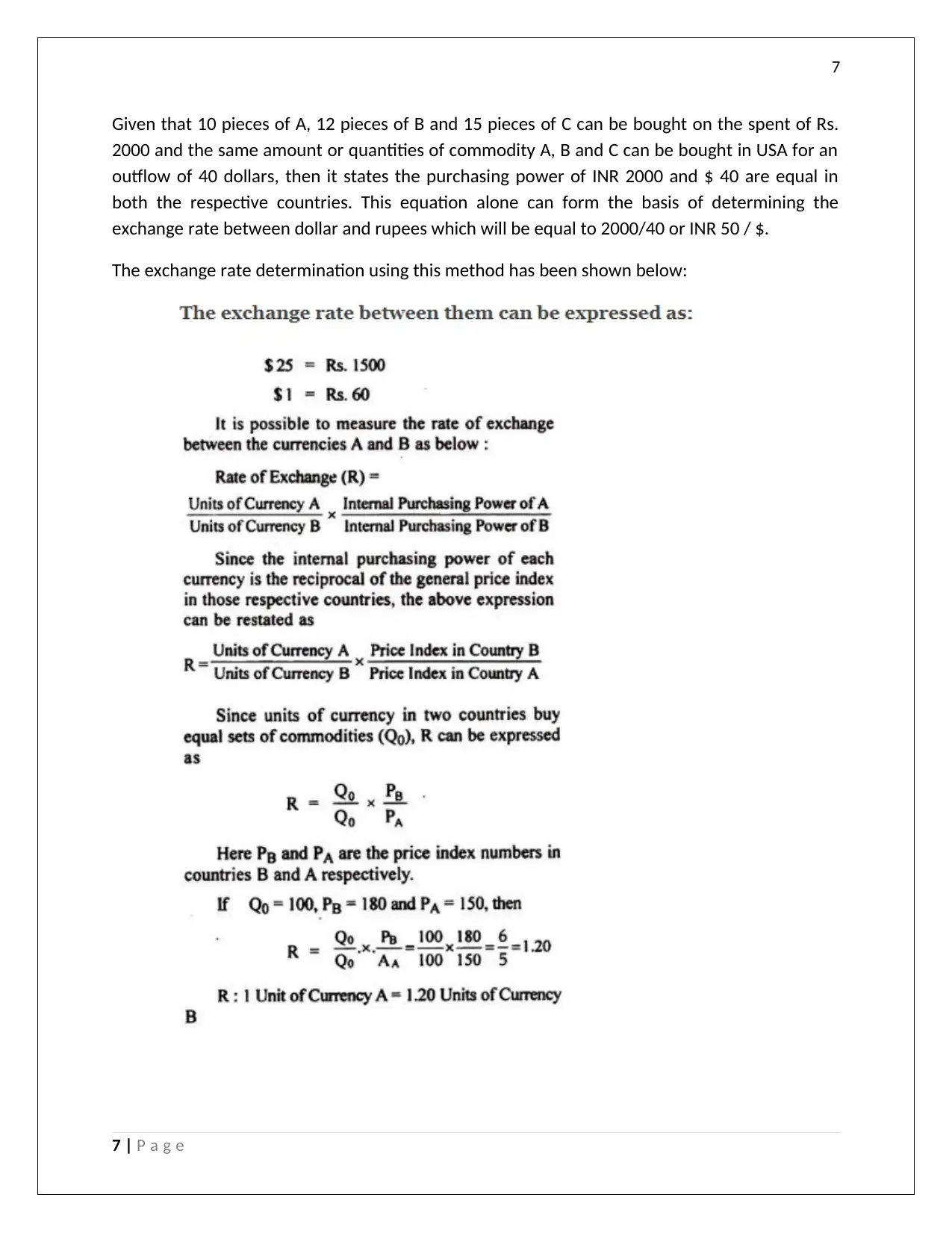
7
Given that 10 pieces of A, 12 pieces of B and 15 pieces of C can be bought on the spent of Rs.
2000 and the same amount or quantities of commodity A, B and C can be bought in USA for an
outflow of 40 dollars, then it states the purchasing power of INR 2000 and $ 40 are equal in
both the respective countries. This equation alone can form the basis of determining the
exchange rate between dollar and rupees which will be equal to 2000/40 or INR 50 / $.
The exchange rate determination using this method has been shown below:
7 | P a g e
Given that 10 pieces of A, 12 pieces of B and 15 pieces of C can be bought on the spent of Rs.
2000 and the same amount or quantities of commodity A, B and C can be bought in USA for an
outflow of 40 dollars, then it states the purchasing power of INR 2000 and $ 40 are equal in
both the respective countries. This equation alone can form the basis of determining the
exchange rate between dollar and rupees which will be equal to 2000/40 or INR 50 / $.
The exchange rate determination using this method has been shown below:
7 | P a g e
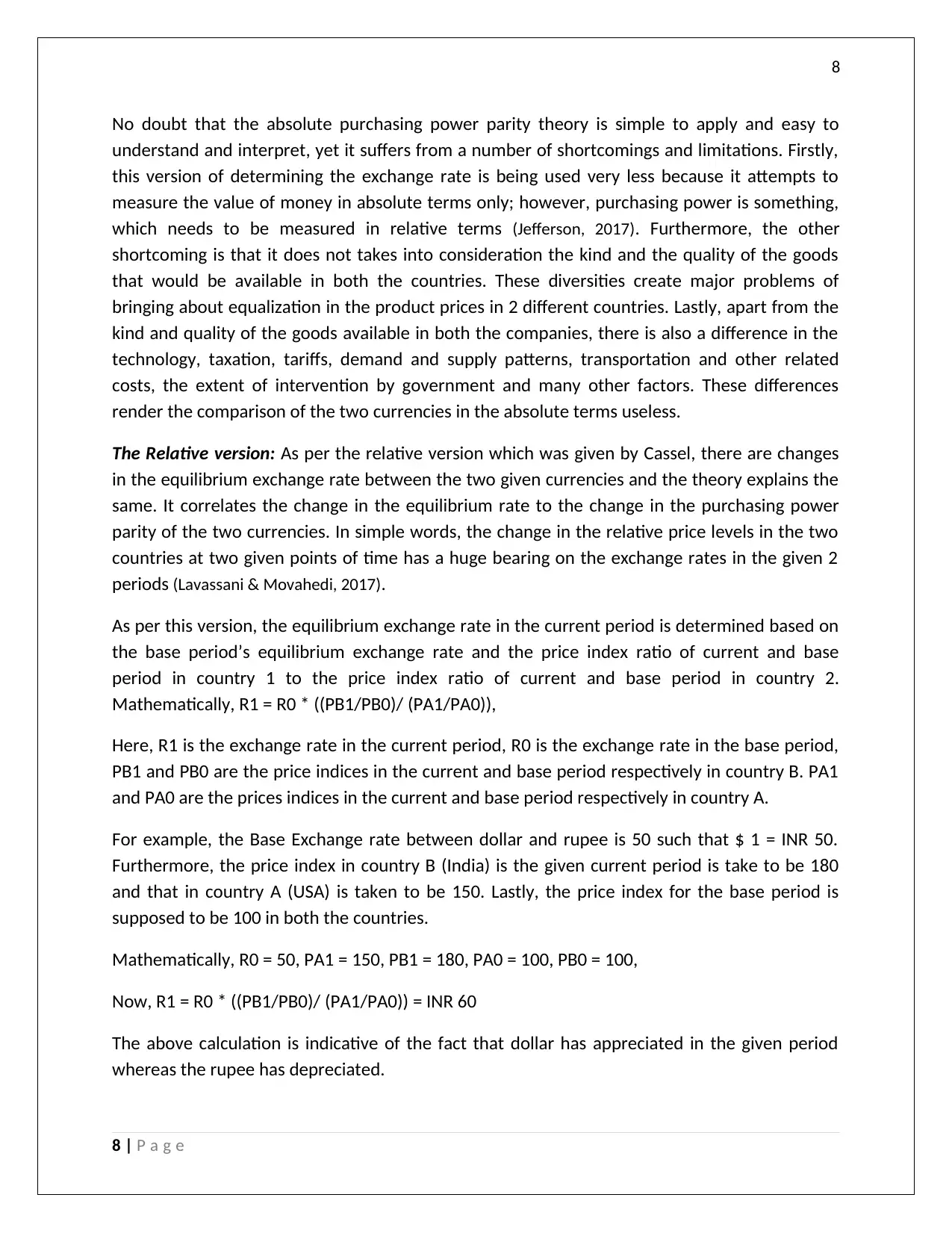
8
No doubt that the absolute purchasing power parity theory is simple to apply and easy to
understand and interpret, yet it suffers from a number of shortcomings and limitations. Firstly,
this version of determining the exchange rate is being used very less because it attempts to
measure the value of money in absolute terms only; however, purchasing power is something,
which needs to be measured in relative terms (Jefferson, 2017). Furthermore, the other
shortcoming is that it does not takes into consideration the kind and the quality of the goods
that would be available in both the countries. These diversities create major problems of
bringing about equalization in the product prices in 2 different countries. Lastly, apart from the
kind and quality of the goods available in both the companies, there is also a difference in the
technology, taxation, tariffs, demand and supply patterns, transportation and other related
costs, the extent of intervention by government and many other factors. These differences
render the comparison of the two currencies in the absolute terms useless.
The Relative version: As per the relative version which was given by Cassel, there are changes
in the equilibrium exchange rate between the two given currencies and the theory explains the
same. It correlates the change in the equilibrium rate to the change in the purchasing power
parity of the two currencies. In simple words, the change in the relative price levels in the two
countries at two given points of time has a huge bearing on the exchange rates in the given 2
periods (Lavassani & Movahedi, 2017).
As per this version, the equilibrium exchange rate in the current period is determined based on
the base period’s equilibrium exchange rate and the price index ratio of current and base
period in country 1 to the price index ratio of current and base period in country 2.
Mathematically, R1 = R0 * ((PB1/PB0)/ (PA1/PA0)),
Here, R1 is the exchange rate in the current period, R0 is the exchange rate in the base period,
PB1 and PB0 are the price indices in the current and base period respectively in country B. PA1
and PA0 are the prices indices in the current and base period respectively in country A.
For example, the Base Exchange rate between dollar and rupee is 50 such that $ 1 = INR 50.
Furthermore, the price index in country B (India) is the given current period is take to be 180
and that in country A (USA) is taken to be 150. Lastly, the price index for the base period is
supposed to be 100 in both the countries.
Mathematically, R0 = 50, PA1 = 150, PB1 = 180, PA0 = 100, PB0 = 100,
Now, R1 = R0 * ((PB1/PB0)/ (PA1/PA0)) = INR 60
The above calculation is indicative of the fact that dollar has appreciated in the given period
whereas the rupee has depreciated.
8 | P a g e
No doubt that the absolute purchasing power parity theory is simple to apply and easy to
understand and interpret, yet it suffers from a number of shortcomings and limitations. Firstly,
this version of determining the exchange rate is being used very less because it attempts to
measure the value of money in absolute terms only; however, purchasing power is something,
which needs to be measured in relative terms (Jefferson, 2017). Furthermore, the other
shortcoming is that it does not takes into consideration the kind and the quality of the goods
that would be available in both the countries. These diversities create major problems of
bringing about equalization in the product prices in 2 different countries. Lastly, apart from the
kind and quality of the goods available in both the companies, there is also a difference in the
technology, taxation, tariffs, demand and supply patterns, transportation and other related
costs, the extent of intervention by government and many other factors. These differences
render the comparison of the two currencies in the absolute terms useless.
The Relative version: As per the relative version which was given by Cassel, there are changes
in the equilibrium exchange rate between the two given currencies and the theory explains the
same. It correlates the change in the equilibrium rate to the change in the purchasing power
parity of the two currencies. In simple words, the change in the relative price levels in the two
countries at two given points of time has a huge bearing on the exchange rates in the given 2
periods (Lavassani & Movahedi, 2017).
As per this version, the equilibrium exchange rate in the current period is determined based on
the base period’s equilibrium exchange rate and the price index ratio of current and base
period in country 1 to the price index ratio of current and base period in country 2.
Mathematically, R1 = R0 * ((PB1/PB0)/ (PA1/PA0)),
Here, R1 is the exchange rate in the current period, R0 is the exchange rate in the base period,
PB1 and PB0 are the price indices in the current and base period respectively in country B. PA1
and PA0 are the prices indices in the current and base period respectively in country A.
For example, the Base Exchange rate between dollar and rupee is 50 such that $ 1 = INR 50.
Furthermore, the price index in country B (India) is the given current period is take to be 180
and that in country A (USA) is taken to be 150. Lastly, the price index for the base period is
supposed to be 100 in both the countries.
Mathematically, R0 = 50, PA1 = 150, PB1 = 180, PA0 = 100, PB0 = 100,
Now, R1 = R0 * ((PB1/PB0)/ (PA1/PA0)) = INR 60
The above calculation is indicative of the fact that dollar has appreciated in the given period
whereas the rupee has depreciated.
8 | P a g e
⊘ This is a preview!⊘
Do you want full access?
Subscribe today to unlock all pages.

Trusted by 1+ million students worldwide
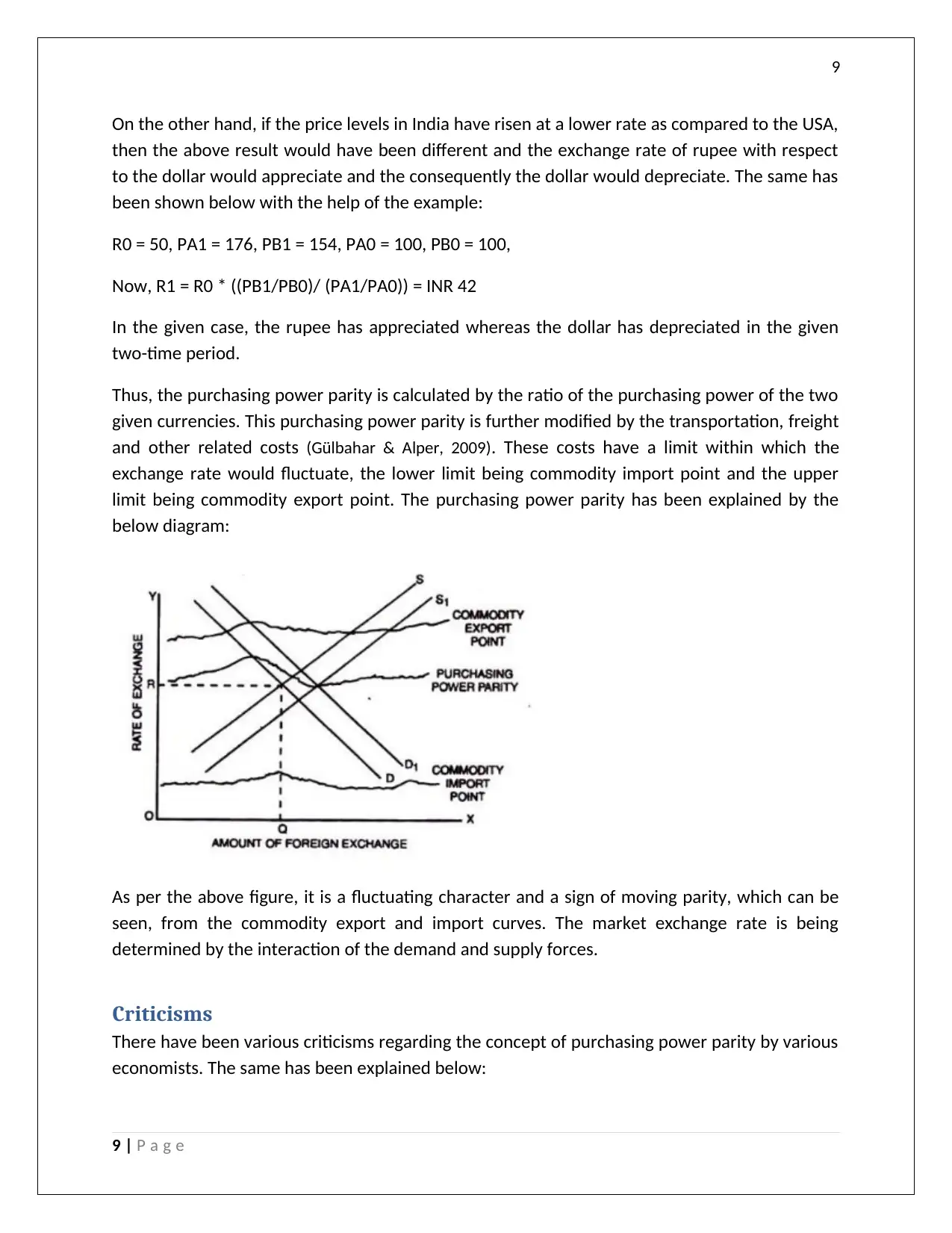
9
On the other hand, if the price levels in India have risen at a lower rate as compared to the USA,
then the above result would have been different and the exchange rate of rupee with respect
to the dollar would appreciate and the consequently the dollar would depreciate. The same has
been shown below with the help of the example:
R0 = 50, PA1 = 176, PB1 = 154, PA0 = 100, PB0 = 100,
Now, R1 = R0 * ((PB1/PB0)/ (PA1/PA0)) = INR 42
In the given case, the rupee has appreciated whereas the dollar has depreciated in the given
two-time period.
Thus, the purchasing power parity is calculated by the ratio of the purchasing power of the two
given currencies. This purchasing power parity is further modified by the transportation, freight
and other related costs (Gülbahar & Alper, 2009). These costs have a limit within which the
exchange rate would fluctuate, the lower limit being commodity import point and the upper
limit being commodity export point. The purchasing power parity has been explained by the
below diagram:
As per the above figure, it is a fluctuating character and a sign of moving parity, which can be
seen, from the commodity export and import curves. The market exchange rate is being
determined by the interaction of the demand and supply forces.
Criticisms
There have been various criticisms regarding the concept of purchasing power parity by various
economists. The same has been explained below:
9 | P a g e
On the other hand, if the price levels in India have risen at a lower rate as compared to the USA,
then the above result would have been different and the exchange rate of rupee with respect
to the dollar would appreciate and the consequently the dollar would depreciate. The same has
been shown below with the help of the example:
R0 = 50, PA1 = 176, PB1 = 154, PA0 = 100, PB0 = 100,
Now, R1 = R0 * ((PB1/PB0)/ (PA1/PA0)) = INR 42
In the given case, the rupee has appreciated whereas the dollar has depreciated in the given
two-time period.
Thus, the purchasing power parity is calculated by the ratio of the purchasing power of the two
given currencies. This purchasing power parity is further modified by the transportation, freight
and other related costs (Gülbahar & Alper, 2009). These costs have a limit within which the
exchange rate would fluctuate, the lower limit being commodity import point and the upper
limit being commodity export point. The purchasing power parity has been explained by the
below diagram:
As per the above figure, it is a fluctuating character and a sign of moving parity, which can be
seen, from the commodity export and import curves. The market exchange rate is being
determined by the interaction of the demand and supply forces.
Criticisms
There have been various criticisms regarding the concept of purchasing power parity by various
economists. The same has been explained below:
9 | P a g e
Paraphrase This Document
Need a fresh take? Get an instant paraphrase of this document with our AI Paraphraser
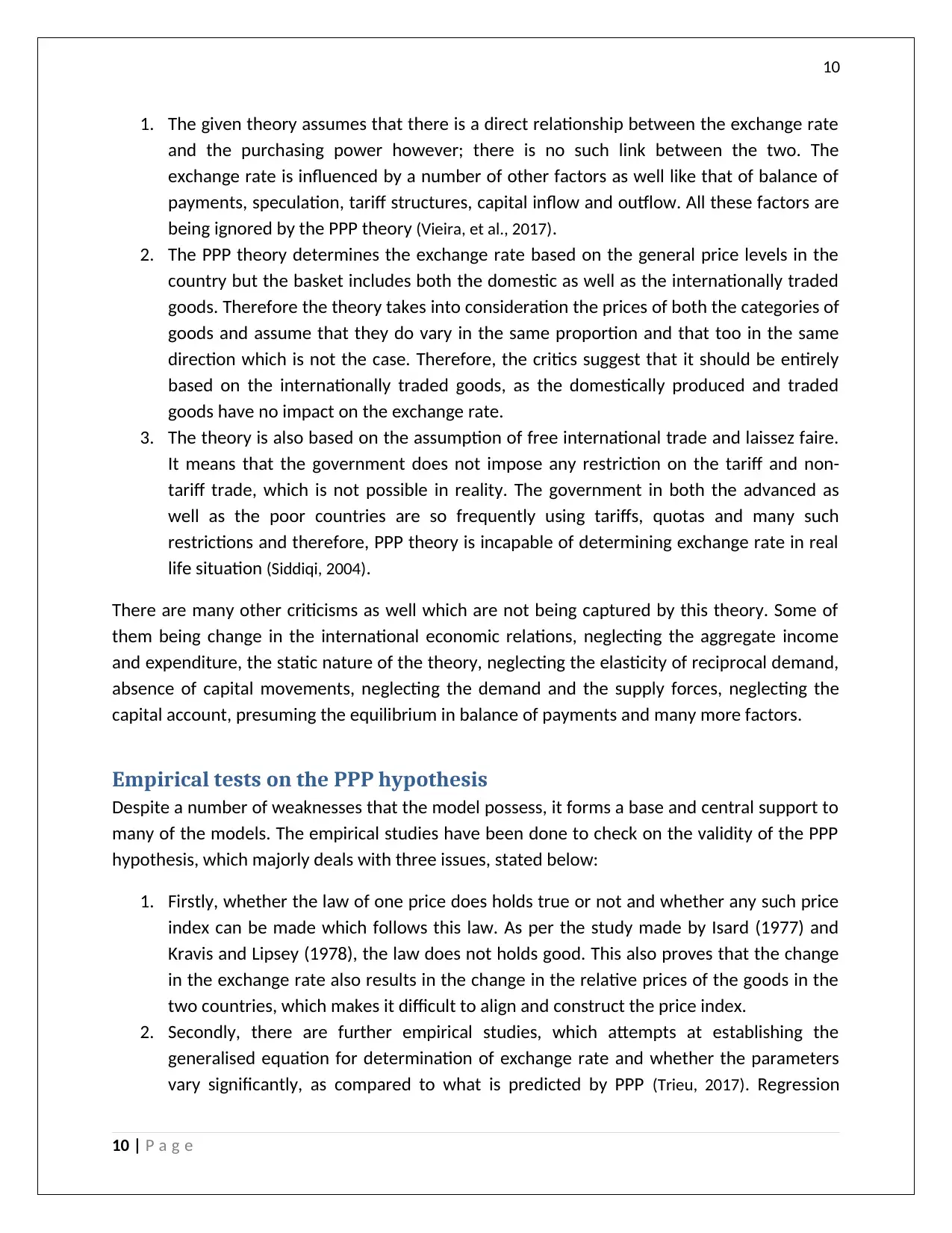
10
1. The given theory assumes that there is a direct relationship between the exchange rate
and the purchasing power however; there is no such link between the two. The
exchange rate is influenced by a number of other factors as well like that of balance of
payments, speculation, tariff structures, capital inflow and outflow. All these factors are
being ignored by the PPP theory (Vieira, et al., 2017).
2. The PPP theory determines the exchange rate based on the general price levels in the
country but the basket includes both the domestic as well as the internationally traded
goods. Therefore the theory takes into consideration the prices of both the categories of
goods and assume that they do vary in the same proportion and that too in the same
direction which is not the case. Therefore, the critics suggest that it should be entirely
based on the internationally traded goods, as the domestically produced and traded
goods have no impact on the exchange rate.
3. The theory is also based on the assumption of free international trade and laissez faire.
It means that the government does not impose any restriction on the tariff and non-
tariff trade, which is not possible in reality. The government in both the advanced as
well as the poor countries are so frequently using tariffs, quotas and many such
restrictions and therefore, PPP theory is incapable of determining exchange rate in real
life situation (Siddiqi, 2004).
There are many other criticisms as well which are not being captured by this theory. Some of
them being change in the international economic relations, neglecting the aggregate income
and expenditure, the static nature of the theory, neglecting the elasticity of reciprocal demand,
absence of capital movements, neglecting the demand and the supply forces, neglecting the
capital account, presuming the equilibrium in balance of payments and many more factors.
Empirical tests on the PPP hypothesis
Despite a number of weaknesses that the model possess, it forms a base and central support to
many of the models. The empirical studies have been done to check on the validity of the PPP
hypothesis, which majorly deals with three issues, stated below:
1. Firstly, whether the law of one price does holds true or not and whether any such price
index can be made which follows this law. As per the study made by Isard (1977) and
Kravis and Lipsey (1978), the law does not holds good. This also proves that the change
in the exchange rate also results in the change in the relative prices of the goods in the
two countries, which makes it difficult to align and construct the price index.
2. Secondly, there are further empirical studies, which attempts at establishing the
generalised equation for determination of exchange rate and whether the parameters
vary significantly, as compared to what is predicted by PPP (Trieu, 2017). Regression
10 | P a g e
1. The given theory assumes that there is a direct relationship between the exchange rate
and the purchasing power however; there is no such link between the two. The
exchange rate is influenced by a number of other factors as well like that of balance of
payments, speculation, tariff structures, capital inflow and outflow. All these factors are
being ignored by the PPP theory (Vieira, et al., 2017).
2. The PPP theory determines the exchange rate based on the general price levels in the
country but the basket includes both the domestic as well as the internationally traded
goods. Therefore the theory takes into consideration the prices of both the categories of
goods and assume that they do vary in the same proportion and that too in the same
direction which is not the case. Therefore, the critics suggest that it should be entirely
based on the internationally traded goods, as the domestically produced and traded
goods have no impact on the exchange rate.
3. The theory is also based on the assumption of free international trade and laissez faire.
It means that the government does not impose any restriction on the tariff and non-
tariff trade, which is not possible in reality. The government in both the advanced as
well as the poor countries are so frequently using tariffs, quotas and many such
restrictions and therefore, PPP theory is incapable of determining exchange rate in real
life situation (Siddiqi, 2004).
There are many other criticisms as well which are not being captured by this theory. Some of
them being change in the international economic relations, neglecting the aggregate income
and expenditure, the static nature of the theory, neglecting the elasticity of reciprocal demand,
absence of capital movements, neglecting the demand and the supply forces, neglecting the
capital account, presuming the equilibrium in balance of payments and many more factors.
Empirical tests on the PPP hypothesis
Despite a number of weaknesses that the model possess, it forms a base and central support to
many of the models. The empirical studies have been done to check on the validity of the PPP
hypothesis, which majorly deals with three issues, stated below:
1. Firstly, whether the law of one price does holds true or not and whether any such price
index can be made which follows this law. As per the study made by Isard (1977) and
Kravis and Lipsey (1978), the law does not holds good. This also proves that the change
in the exchange rate also results in the change in the relative prices of the goods in the
two countries, which makes it difficult to align and construct the price index.
2. Secondly, there are further empirical studies, which attempts at establishing the
generalised equation for determination of exchange rate and whether the parameters
vary significantly, as compared to what is predicted by PPP (Trieu, 2017). Regression
10 | P a g e
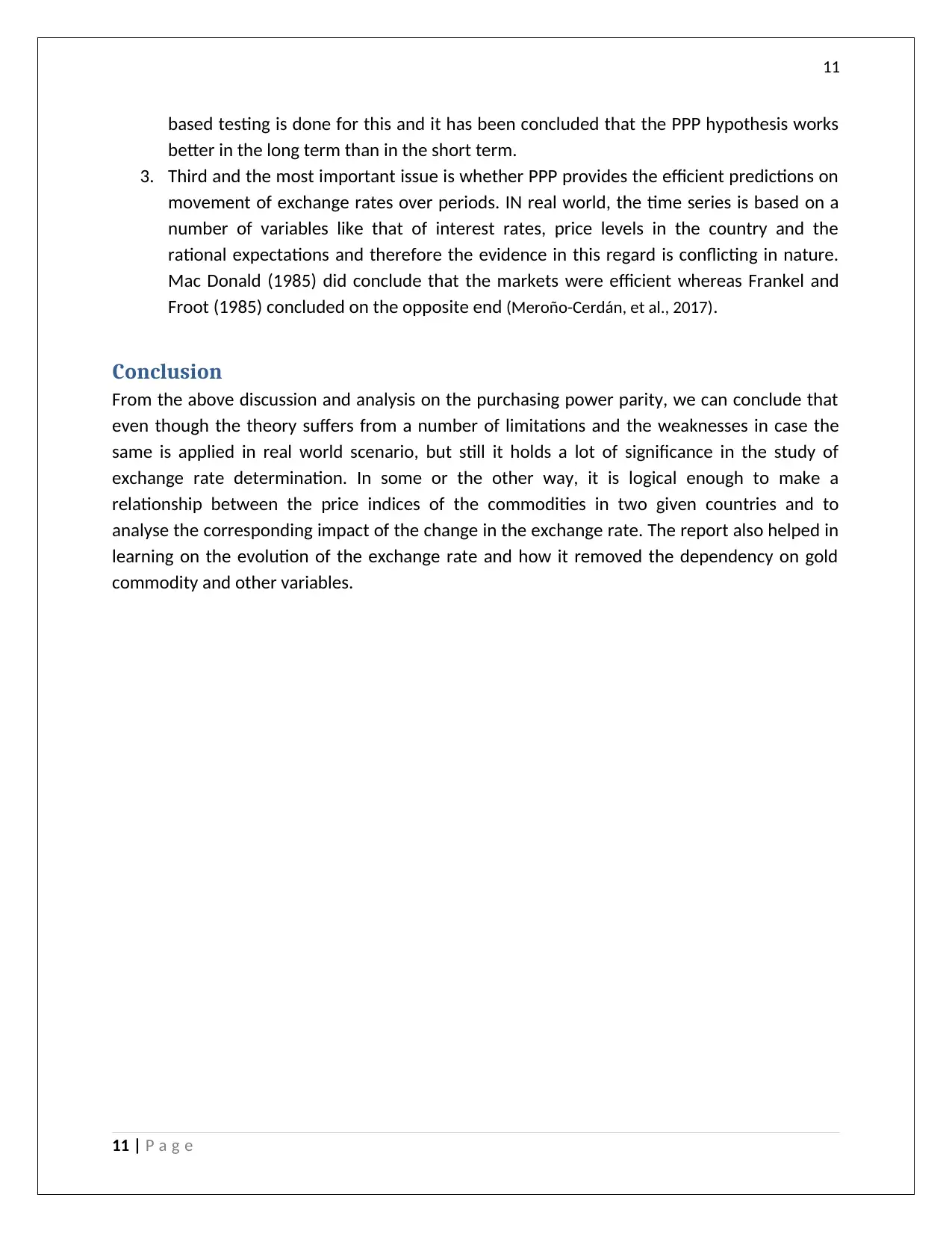
11
based testing is done for this and it has been concluded that the PPP hypothesis works
better in the long term than in the short term.
3. Third and the most important issue is whether PPP provides the efficient predictions on
movement of exchange rates over periods. IN real world, the time series is based on a
number of variables like that of interest rates, price levels in the country and the
rational expectations and therefore the evidence in this regard is conflicting in nature.
Mac Donald (1985) did conclude that the markets were efficient whereas Frankel and
Froot (1985) concluded on the opposite end (Meroño-Cerdán, et al., 2017).
Conclusion
From the above discussion and analysis on the purchasing power parity, we can conclude that
even though the theory suffers from a number of limitations and the weaknesses in case the
same is applied in real world scenario, but still it holds a lot of significance in the study of
exchange rate determination. In some or the other way, it is logical enough to make a
relationship between the price indices of the commodities in two given countries and to
analyse the corresponding impact of the change in the exchange rate. The report also helped in
learning on the evolution of the exchange rate and how it removed the dependency on gold
commodity and other variables.
11 | P a g e
based testing is done for this and it has been concluded that the PPP hypothesis works
better in the long term than in the short term.
3. Third and the most important issue is whether PPP provides the efficient predictions on
movement of exchange rates over periods. IN real world, the time series is based on a
number of variables like that of interest rates, price levels in the country and the
rational expectations and therefore the evidence in this regard is conflicting in nature.
Mac Donald (1985) did conclude that the markets were efficient whereas Frankel and
Froot (1985) concluded on the opposite end (Meroño-Cerdán, et al., 2017).
Conclusion
From the above discussion and analysis on the purchasing power parity, we can conclude that
even though the theory suffers from a number of limitations and the weaknesses in case the
same is applied in real world scenario, but still it holds a lot of significance in the study of
exchange rate determination. In some or the other way, it is logical enough to make a
relationship between the price indices of the commodities in two given countries and to
analyse the corresponding impact of the change in the exchange rate. The report also helped in
learning on the evolution of the exchange rate and how it removed the dependency on gold
commodity and other variables.
11 | P a g e
⊘ This is a preview!⊘
Do you want full access?
Subscribe today to unlock all pages.

Trusted by 1+ million students worldwide
1 out of 14
Related Documents
Your All-in-One AI-Powered Toolkit for Academic Success.
+13062052269
info@desklib.com
Available 24*7 on WhatsApp / Email
![[object Object]](/_next/static/media/star-bottom.7253800d.svg)
Unlock your academic potential
Copyright © 2020–2025 A2Z Services. All Rights Reserved. Developed and managed by ZUCOL.




